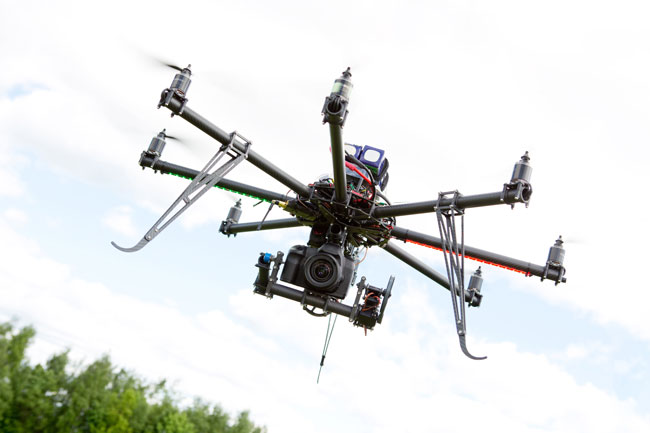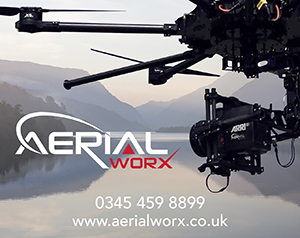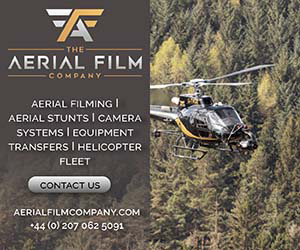Broadcast News
01/07/2015
Are Drones Really The Future Of Filming?

Most widely known as devices used by the military, drones are vastly becoming the broadcasting and film industry’s weapon of choice when it comes to the battle for the best blockbuster. Drones, professionally referred to as UAVs or RPAS, are the next step in aerial filming technology. With possibilities for film, television, live broadcasting, aerial photography and advertising it is no surprise that UAVs are becoming the latest addition to the broadcasting toolkit.
UAVs are increasingly being used in a number of high profile films and documentaries, with the technology used in everything from the latest James Bond instalment to Game of Thrones and the Avengers: Age of Ultron. Getting the scene and camera angle right first time can require military precision and that’s exactly what drone technology can offer. UAVs are also becoming increasingly prominent for live broadcasting applications, with the tech used to broadcast footage of the US Open held in June of this year.
UAVs remove the constraints presented by large pieces of filming equipment offering an alternative to booms, tracks cams, jib, cranes and helicopters. With a quick set-up time and at a fraction of the cost of traditional aerial filming techniques, UAVs are a cost and time-effective alternative for the film and broadcast industry. With the technology rapidly evolving UAVs are also achieving phenomenal, previously unattainable footage, offering an unparalleled viewpoint for filmmakers. Stabilised gimbals and camera systems have optimised UAVs for filming purposes, whilst increasing payloads are enabling UAVs to be compatible with a broad range of cameras and lenses. 4K resolution HD filming is now easily achievable with UAVs and with many companies now designing custom-built aerial camera drones specifically for the cinematography and broadcasting community the possibilities for this technology are continually growing.
Battery life for UAVs at present varies depending on the kit you are using, with flight times ranging from approximately 10-20 minutes. Some critics have dismissed the use of UAVs for the filming industry based upon their minimal battery life, however with more innovative power sources, such as hydrogen, and new battery designs emerging UAVs are set to move from minutes to hours of flying time.
Make no mistake though, not just anyone can fly a UAV, training is a must! In the face of a number of recent incidents involving the misuse of UAVs, safety, training and insurance are of paramount importance. The industry has a number of basic regulations which must be followed by anyone operating a UAV: UAVs can be flown up to 400ft altitude, 500m horizontally (in order to maintain visual line of sight with the UAV), and must be kept 50m away from buildings and people. If you plan to use a UAV for commercial purposes you must gain a Permission For Aerial Work (PFAW) from the Civil Aviation Authority. In order to gain a PFAW you must complete pilot competency training. This training is currently available from seven CAA approved training providers known as National Qualified Entities (NQE). There are now also a number of specialised UAV insurance providers within the industry who should be a first point-of-call before any UAV operations.
Are drones really the future of filming? Only time will tell. What is clear is that UAVs are undoubtedly becoming a key piece of broadcasting kit, perfectly suited to a range of filming applications, and free from the limitations of more traditional filming methods. This rapidly expanding industry is certainly one to watch. To discover more about the use of UAVs for the filming & broadcasting industries, and to check out the latest in drone technology, visit the SkyTech 2016 event taking place in London on the 27th & 28th January.
For more information about CAA approved training providers and how to gain a PFAW visit the CAA website www.caa.co.uk.
UAVs are increasingly being used in a number of high profile films and documentaries, with the technology used in everything from the latest James Bond instalment to Game of Thrones and the Avengers: Age of Ultron. Getting the scene and camera angle right first time can require military precision and that’s exactly what drone technology can offer. UAVs are also becoming increasingly prominent for live broadcasting applications, with the tech used to broadcast footage of the US Open held in June of this year.
UAVs remove the constraints presented by large pieces of filming equipment offering an alternative to booms, tracks cams, jib, cranes and helicopters. With a quick set-up time and at a fraction of the cost of traditional aerial filming techniques, UAVs are a cost and time-effective alternative for the film and broadcast industry. With the technology rapidly evolving UAVs are also achieving phenomenal, previously unattainable footage, offering an unparalleled viewpoint for filmmakers. Stabilised gimbals and camera systems have optimised UAVs for filming purposes, whilst increasing payloads are enabling UAVs to be compatible with a broad range of cameras and lenses. 4K resolution HD filming is now easily achievable with UAVs and with many companies now designing custom-built aerial camera drones specifically for the cinematography and broadcasting community the possibilities for this technology are continually growing.
Battery life for UAVs at present varies depending on the kit you are using, with flight times ranging from approximately 10-20 minutes. Some critics have dismissed the use of UAVs for the filming industry based upon their minimal battery life, however with more innovative power sources, such as hydrogen, and new battery designs emerging UAVs are set to move from minutes to hours of flying time.
Make no mistake though, not just anyone can fly a UAV, training is a must! In the face of a number of recent incidents involving the misuse of UAVs, safety, training and insurance are of paramount importance. The industry has a number of basic regulations which must be followed by anyone operating a UAV: UAVs can be flown up to 400ft altitude, 500m horizontally (in order to maintain visual line of sight with the UAV), and must be kept 50m away from buildings and people. If you plan to use a UAV for commercial purposes you must gain a Permission For Aerial Work (PFAW) from the Civil Aviation Authority. In order to gain a PFAW you must complete pilot competency training. This training is currently available from seven CAA approved training providers known as National Qualified Entities (NQE). There are now also a number of specialised UAV insurance providers within the industry who should be a first point-of-call before any UAV operations.
Are drones really the future of filming? Only time will tell. What is clear is that UAVs are undoubtedly becoming a key piece of broadcasting kit, perfectly suited to a range of filming applications, and free from the limitations of more traditional filming methods. This rapidly expanding industry is certainly one to watch. To discover more about the use of UAVs for the filming & broadcasting industries, and to check out the latest in drone technology, visit the SkyTech 2016 event taking place in London on the 27th & 28th January.
For more information about CAA approved training providers and how to gain a PFAW visit the CAA website www.caa.co.uk.
More Aerial Filming Stories
31/01/2023
Flying Features Relies On LiveU
For the third year in a row, the Santos Tour Down Under cycling race was broadcast live from the sky by Australian aerial filming company Flying Featu
Flying Features Relies On LiveU
For the third year in a row, the Santos Tour Down Under cycling race was broadcast live from the sky by Australian aerial filming company Flying Featu
02/06/2017
Live Video Streaming From Drones
Drones provide a mechanism for streaming compelling video that other methods cannot compete with, either from an infrastructure or cost prospective. W
Live Video Streaming From Drones
Drones provide a mechanism for streaming compelling video that other methods cannot compete with, either from an infrastructure or cost prospective. W
26/04/2017
360 Design Announce Flying EYE
360 Designs has announced the launch of Flying EYE, a groundbreaking, 6K, broadcast quality, live streaming VR drone. According to the company the ann
360 Design Announce Flying EYE
360 Designs has announced the launch of Flying EYE, a groundbreaking, 6K, broadcast quality, live streaming VR drone. According to the company the ann
12/04/2017
Festival Recognition For Shetland My Land, My Home
Article contributed by Thomas Haywood, from Thomas Haywood Aerial Photography. Recently, I entered Shetland My Land, My Home into several film festiva
Festival Recognition For Shetland My Land, My Home
Article contributed by Thomas Haywood, from Thomas Haywood Aerial Photography. Recently, I entered Shetland My Land, My Home into several film festiva
31/03/2017
Drone Use In Construction Industry - Part 1
In the first of a two-part report into drones and construction, Jim Meehan, an aerial imaging specialist at SkyHeld Cameras, asks if data quality or s
Drone Use In Construction Industry - Part 1
In the first of a two-part report into drones and construction, Jim Meehan, an aerial imaging specialist at SkyHeld Cameras, asks if data quality or s
31/03/2017
Drone Use In Construction Industry - Part 2
In the second of a two-part report into drones and construction Jim Meehan, aerial imaging specialist at SkyHeld Cameras, rounds up the reasons that d
Drone Use In Construction Industry - Part 2
In the second of a two-part report into drones and construction Jim Meehan, aerial imaging specialist at SkyHeld Cameras, rounds up the reasons that d
30/03/2017
GoPro Karma Now Available In The UK
GoPro have announced that it's complete Karma system is now available at selected online and high street retailers. Karma features a compact design an
GoPro Karma Now Available In The UK
GoPro have announced that it's complete Karma system is now available at selected online and high street retailers. Karma features a compact design an
08/03/2017
Hovercam Goes On The Hunt For Sharks
Hovercam's Benet Allen went shark-baiting with the team from ITV's Fishing Impossible... They told us it was going to be straightforward, if a bit sme
Hovercam Goes On The Hunt For Sharks
Hovercam's Benet Allen went shark-baiting with the team from ITV's Fishing Impossible... They told us it was going to be straightforward, if a bit sme
23/01/2017
Producing Live UHD/4K Aerial Footage On Budget
Just a few years ago, the only option of producing professional, dynamic live aerial footage was renting a turbine driven helicopter equipped with a h
Producing Live UHD/4K Aerial Footage On Budget
Just a few years ago, the only option of producing professional, dynamic live aerial footage was renting a turbine driven helicopter equipped with a h
20/01/2017
BFV's Big Interview: BeyondHD
With 20 years specialising in aerial and vehicle-based stabilised remote head filming equipment and crew hire – from manned aerial filming and class l
BFV's Big Interview: BeyondHD
With 20 years specialising in aerial and vehicle-based stabilised remote head filming equipment and crew hire – from manned aerial filming and class l















